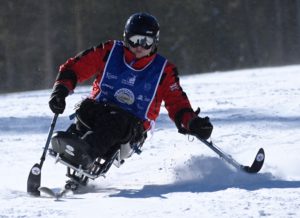
5 Facts You Need to Know About Corticosteroids V. Anabolic Steroids
 When athletes or their parents hear the word ‘steroid,’ they may envision a muscle-building, performance-enhancing drug that not only destroys the integrity of sport, but also comes with extreme health risks – especially for young athletes.
When athletes or their parents hear the word ‘steroid,’ they may envision a muscle-building, performance-enhancing drug that not only destroys the integrity of sport, but also comes with extreme health risks – especially for young athletes.
When it comes to steroids, however, that description is only one piece of the equation. There are actually multiple classes of steroids, including anabolic steroids and corticosteroids, which have different uses, side effects, and performance-enhancing qualities.
Amy Eichner, PhD, U.S. Anti-Doping Agency’s Special Advisor on Drug Reference and Supplements, explains five things you need to know about steroids, including the difference between corticosteroids and anabolic steroids.
What are steroids?
Steroids are a class of compounds that all have a similar structure and bind to hormone receptors in the body. Anabolic steroids bind to the androgen receptors, whereas corticosteroids bind to the glucocorticoid receptors – leading to different effects on the body.
The body naturally produces testosterone, an anabolic steroid, that regulates bone and muscle mass and fat distribution, as well as sex-drive (libido) and red blood cell production. The body also naturally produces cortisol, a corticosteroid. When cortisol binds to the glucocorticosteroid receptor, it activates a metabolic pathway that suppresses inflammation and immune responses.
There are also many synthetically produced anabolic and corticosteroid compounds, some of which are legitimate medicines and some of which are not.
What are they used for?
Prescription use of testosterone can be used to treat hypogonadism in men, or to prevent the loss of muscle associated with Hiv infection. In some teenage boys that have been diagnosed with delayed onset of puberty or a genetic abnormality, testosterone injections are sometimes prescribed to kick-start growth and development.
Corticoids are often prescribed to reduce inflammation and allergic reactions. Corticosteroid creams can be applied to the skin to treat poison ivy rashes, or contact dermatitis, whereas corticosteroids in pill form can be taken to treat allergies, as well as autoimmune disorders like lupus or rheumatoid arthritis. Inhaled corticosteroids are effective in treating asthma, and corticosteroid injections into joints can treat inflammation related to sport injuries or arthritis.
Are there side effects with steroid use?
Corticoids and anabolic steroids not only differ in the primary medical uses, but also in their potential health risks and side effects.
The U.S. Anti-Doping Agency lists some physiological effects of both, as well as psychological effects from anabolic steroids:
CORTICOIDS
|
ANABOLIC Steroids
|
|
NOTE: * Effects may be permanent and can vary by individual.
Why are steroids considered performance-enhancing drugs in sport?
Anabolic steroids are performance enhancing because they have such profound, long-term (several months) effects on muscle mass and strength. Athletes that use anabolic steroids still benefit from their effects long after they stop using them. For this reason, anabolic steroids are prohibited at all times, during competition and in the off-season, by athletes subject to anti-doping rules.
Corticosteroids offer more immediate performance-enhancing benefits. Injections into muscle or oral corticosteroids reduce the pain and inflammation that often occurs with extreme exertion. Athletes have reported that corticosteroids help them push through the pain of extreme exertion and allow them to recover faster for the next event. The benefits of corticosteroids wear off pretty fast, which is why they are prohibited in-competition only.
What are the warning signs of anabolic steroid abuse?
Some teenagers abuse anabolic steroids in order to build muscle and get the body they want. Parents are often very surprised to learn how easy it is for their kids to access illegal steroids. The Fda has issued warnings about such abuse.
 If an athlete is abusing anabolic steroids to enhance their performance, there are a few patterns of use they may employ:
If an athlete is abusing anabolic steroids to enhance their performance, there are a few patterns of use they may employ:
- Cycling: The person ingests anabolic steroids in cycles of 6-12 weeks (known as the “on” period), followed by four weeks to several months off.
- Stacking: Users combine several different types of steroids or incorporate other supplements in an attempt to maximize the effectiveness of the steroids. This is called “stacking.”
- Pyramiding: Some users gradually increase the dose to a peak, then reduce the amount.
According to a report, 3.3 percent of high school students admit to anabolic steroid use and another study found that 8 percent of girls and 12 percent of boys report using products to improve appearance, muscle mass, or strength.
If you suspect your athlete is abusing steroids, here are gender-specific physical changes to look for:
|
|
NOTE: * Effects may be permanent and can vary by individual.
If your athlete has been misusing anabolic steroids and they suddenly stop taking them, they can also exhibit symptoms of withdrawal, which include:
- Fatigue
- Restlessness
- Mood swings
- Depression
- Insomnia
- Cravings
_____
Help your athlete understand that there are serious health consequences associated with the use of steroids, especially anabolic steroids. These substances can end up illegally in supplements and are fairly accessible on store shelves and online, so your awareness and diligence is critical.

About TrueSport
TrueSport®, a movement powered by the experience and values of the U.S. Anti-Doping Agency, champions the positive values and life lessons learned through youth sport.
TrueSport® inspires athletes, coaches, parents, and administrators to change the culture of youth sport through active engagement and thoughtful curriculum based on cornerstone lessons of sportsmanship, character-building, and clean and healthy performance, by creating leaders across communities through sport.


